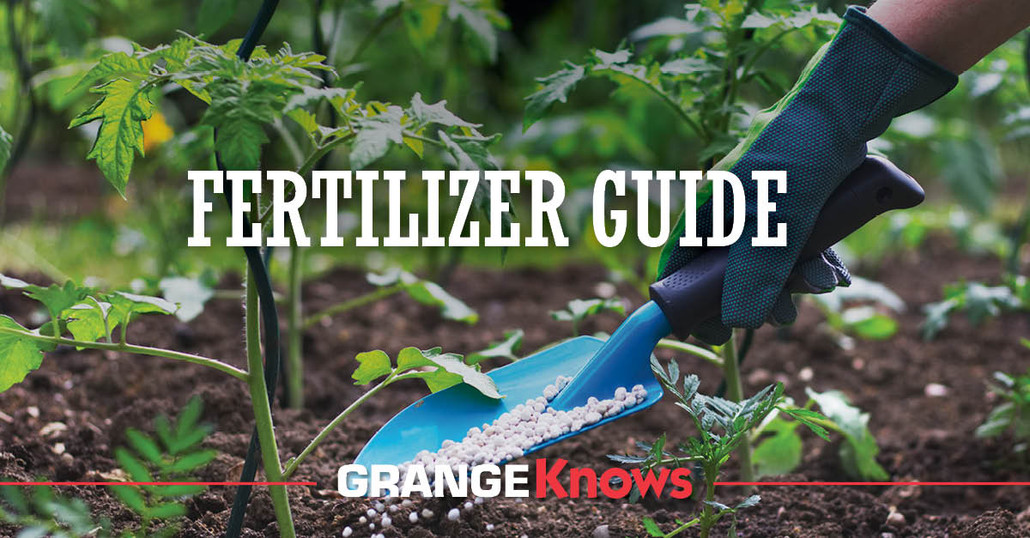
Fertilizer Guide
Posted by Grange Co-op on 17th Jun 2020
Plants need occasional fertilizer feedings because most soil does not provide the essential nutrients required for optimum growth. Even the best garden soil will eventually be depleted of nutrients as the plants growing in it absorb the nutrients from the soil. Replenishing lost nutrients is the primary reason we recommend fertilizing for the healthiest of plants. Grange Co-op Gardening Expert, Kraig Rucker, discusses fertilizer basics, explaining NPK values and recommending some of our favorite beneficial fertilizers this spring.
Proper fertilizing can unlock your lawn or garden’s greatest potential. But for many, fertilizing can be intimidating and uncharted territory. We’re here to ease your uncertainties! When shopping for fertilizer, you may notice all fertilizer products list three bold numbers, this label is known as the fertilizer grade and is the national standard for fertilizers. The first number is the amount of nitrogen (N), the second number is the amount of phosphate (P2O5) and the third number is the amount of potash (K2O). These three numbers represent the primary nutrients (nitrogen(N) – phosphorus(P) – potassium(K)). Each of these nutrients aid plants in particular ways, the higher the number, the more concentrated the nutrient is in the fertilizer.
Nitrogen (N) is largely responsible for the vegetative, green growth of the leaves on the plant. Lawn grass, corn and plants similarly with greater amounts of foliage need lots of nitrogen to thrive.
Phosphorus (P) aids in root, flower and fruit development. Phosphorus is extremely important for growing vegetables and hanging baskets. Phosphorus doesn’t specifically make the plant larger, but instead instigates flower and fruit production. We recommend an organic fertilizer from G&B Organics: Hi-Bloom 1-3-1. Referencing the NPK values, you can see this fertilizer has 3x the amount of phosphorus as nitrogen.
Potassium (K) is a nutrient that helps with the overall health of the plant. For vegetable plants you generally don’t focus highly on replenishing this.
Along with these three nutrients, and just as important to a plant’s health, is carbon from CO2 in the air, hydrogen from water, and oxygen from the water and air. Well-fed plants are healthier and more productive, it is vital the plants you’re growing receive the proper amount of each of these.
ORGANIC VS. NON-ORGANIC
Grange Co-op carries a wide selection of fertilizers. Feel free to visit any one of our stores to receive the assistance you need from a Grange Gardening Expert. Depending on the type of plants you’re fertilizing, your soil type and location, we can help you choose the right fertilizer. However, in spring, starting gardens and during a time that many call ‘fertilizer-season’ we recommend an even-ratio-fertilizer to get the most out of the growing season. Often referred to as ‘all-purpose’ fertilizers, these are generally formulated with an even-ratio of NPK values (such as a 10-10-10). The fertilizer referenced here is G&B Organics All Purpose Fertilizer (3-2-3). This liquid fertilizer promotes a healthy soil structure resulting in lush, full plant growth. This all-purpose fertilizer is designed to provide faster, more balanced nutrients for a wide variety of flowers and plants. A comparable product, in a granular version, is G&B Organics All Purpose Fertilizer (4-4-4). This blend of natural ingredients will feed plants quickly, as well as continue feeding for several months! This even ratio is perfect for mixing into the soil at time of planting, then sit back and watch the benefits it has on your plants throughout the growing season.
COMMON MISTAKES
When planting tomatoes and even some peppers, purchase a fertilizer that specifically states its for those plants. If it does not specifically state that it is a fertilizer for tomatoes/peppers, we recommend purchasing calcium in addition to the fertilizer. Larger tomatoes, especially, are prone to getting blossom end rot. This happens when there isn’t enough calcium in the soil, causing the cell walls of the blossom end of the fruit to break down. It looks like a scab on the fruit, making that portion of the tomato or pepper inedible. This is one of the most common mistakes gardeners make every year. And while there are products that can stop the effects of blossom end rot in future fruits the plant will produce, it is much easier to prevent blossom end rot than it is to treat. We recommend G&B Tomato, Vegetable & Herb fertilizer (4-6-3). This fertilizer contains nutrients that inhibit blossom end rot, making it excellent for tomatoes, other vegetables & herbs; helping to produce more abundant crops that are better tasting and more nutritious. It is made from 100% natural and organic ingredients with quick-released nutrients, as well as slow released nutrients to feed for several months.
Unlock the potential your soil has to produce beautiful and healthy plants with the power of proper fertilizing. Always follow label instructions and for assistance or additional information on fertilization, visit our GrangeKnows page online or in-store for more help. Thank you to our GrangeGardening Expert, Kraig, for his educational video and happy planting!
